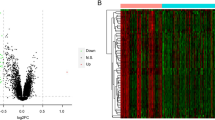Abstract
Alzheimer’s disease (AD) is one of the most common types of dementia among the elderly. Previous studies had revealed that the dysregulation of lncRNAs played important roles in human diseases, including AD. However, there is still a lack of comprehensive analysis of differently expressed long non-coding RNAs (lncRNAs) in different distinct regions related to AD. In present study, we identified a total of 678, 593, 941, 1445, 1179, 466 differently expressed lncRNAs that were found in entorhinal cortex (EC), middle temporal gyrus(MTG), hippocampus (HIP), superior frontal gyrus (SFG), posterior cingulate (PC), cortex and primary visual cortex (VCX) AD samples, respectively. Furthermore, we constructed lncRNA–mRNA co-expression networks in AD to explore the potential roles of these lncRNAs. Differentially expressed (DE) lncRNAs were involved in regulating metabolic process, respiratory electron transport chain and ATP metabolic process showed by GO analysis. Interestingly, KEGG analysis revealed these lncRNAs were associated with neurodegenerative disorders such as Alzheimer’s disease, Huntington’s disease and Parkinson’s disease. Four lncRNAs (LOC100507557, LOC101929787, NEAT1, and JAZF1-AS1) were identified as key lncRNAs in AD progression and dysregulated in different distinct regions related to AD. Our study has uncovered several key lncRNAs in AD, which would give novel underlying therapeutic and prognostic targets for AD.






Similar content being viewed by others
References
Li J, Xuan Z, Liu C (2013) Long non-coding RNAs and complex human diseases. Int J Mol Sci 14(9):18790–18808
Zhang A, Xu M, Mo YY (2014) Role of the lncRNA-p53 regulatory network in cancer. J Mol Cell Biol 6(3):181–191
Liu JY et al (2014) Pathogenic role of lncRNA-MALAT1 in endothelial cell dysfunction in diabetes mellitus. Cell Death Dis 5:e1506
Xing D et al (2014) Identification of long noncoding RNA associated with osteoarthritis in humans. Orthop Surg 6(4):288–293
Chuang TD, Khorram O (2018) Expression Profiling of lncRNAs, miRNAs, and mRNAs and their differential expression in leiomyoma using next-generation RNA sequencing. Reprod Sci 25(2):246–255
Zhang B et al (2014) A novel RNA motif mediates the strict nuclear localization of a long noncoding RNA. Mol Cell Biol 34(12):2318–2329
Zhou X et al (2015) The interaction between MiR-141 and lncRNA-H19 in regulating cell proliferation and migration in gastric cancer. Cell Physiol Biochem 36(4):1440–1452
Wu G et al (2014) LincRNA-p21 regulates neointima formation, vascular smooth muscle cell proliferation, apoptosis, and atherosclerosis by enhancing p53 activity. Circulation 130(17):1452–1465
Gonzalez I et al (2015) A lncRNA regulates alternative splicing via establishment of a splicing-specific chromatin signature. Nat Struct Mol Biol 22(5):370–376
Wan G et al (2014) Noncoding RNAs in DNA repair and genome integrity. Antioxid Redox Signal 20(4):655–677
Ubhi K, Masliah E (2013) Alzheimer’s disease: recent advances and future perspectives. J Alzheimers Dis 33(Suppl 1):S185–S194
Lukiw WJ et al (2012) Studying micro RNA function and dysfunction in Alzheimer’s Disease. Front Genet 3:327
Rijal UA et al (2014) Biochemical stages of amyloid-beta peptide aggregation and accumulation in the human brain and their association with symptomatic and pathologically preclinical Alzheimer’s disease. Brain 137(Pt 3):887–903
Nie J et al (2016) Dendrobium alkaloids prevent Abeta25-35-induced neuronal and synaptic loss via promoting neurotrophic factors expression in mice. PeerJ 4:e2739
Cirillo C et al (2015) S100B inhibitor pentamidine attenuates reactive gliosis and reduces neuronal loss in a mouse model of Alzheimer’s disease. Biomed Res Int 508342
Gu C et al (2018) Long noncoding RNA EBF3-AS promotes neuron apoptosis in Alzheimer’s disease. DNA Cell Biol
Zhou X, Xu J (2015) Identification of Alzheimer’s disease-associated long noncoding RNAs. Neurobiol Aging 36(11):2925–2931
Liang WS et al (2007) Gene expression profiles in anatomically and functionally distinct regions of the normal aged human brain. Physiol Genomics 28(3):311–322
Liang WS et al (2008) Alzheimer’s disease is associated with reduced expression of energy metabolism genes in posterior cingulate neurons. Proc Natl Acad Sci USA 105(11):4441–4446
Wettenhall JM, Smyth GK (2004) limmaGUI: a graphical user interface for linear modeling of microarray data. Bioinformatics 20(18):3705–3706
Gallon S, Loubes JM, Maza E (2013) Statistical properties of the quantile normalization method for density curve alignment. Math Biosci 242(2):129–142
Lam B et al (2013) Clinical, imaging, and pathological heterogeneity of the Alzheimer’s disease syndrome. Alzheimers Res Ther 5(1):1
Patel A et al (2011) Association of variants within APOE, SORL1, RUNX1, BACE1 and ALDH18A1 with dementia in Alzheimer’s disease in subjects with Down syndrome. Neurosci Lett 487(2):144–148
Shi X et al (2013) Long non-coding RNAs: a new frontier in the study of human diseases. Cancer Lett 339(2):159–166
Fang M et al (2017) Bioinformatics and co-expression network analysis of differentially expressed lncRNAs and mRNAs in hippocampus of APP/PS1 transgenic mice with Alzheimer disease. Am J Transl Res 9(3):1381–1391
Imamura K et al (2014) Long noncoding RNA NEAT1-dependent SFPQ relocation from promoter region to paraspeckle mediates IL8 expression upon immune stimuli. Mol Cell 53(3):393–406
Chakravarty D et al (2014) The oestrogen receptor alpha-regulated lncRNA NEAT1 is a critical modulator of prostate cancer. Nat Commun 5:5383
Wang Y et al., C/EBPbeta contributes to transcriptional activation of long non-coding RNA NEAT1 during APL cell differentiation. Biochem Biophys Res Commun, 2017
Wang Q et al (2017) NEAT1/miR-181c regulates osteopontin (OPN)-mediated synoviocyte proliferation in osteoarthritis. J Cell Biochem 118(11):3775–3784
Author information
Authors and Affiliations
Contributions
Conception and design: JW; JJW; development of methodology: LHC; CBZ; analysis and interpretation of data: SHX; YHG; writing, review, and/or revision of manuscript: JW; LHC; JJW.
Corresponding author
Ethics declarations
Conflict of Interest
The authors declare that they have no competing interests.
Ethical Approval
This article does not contain any studies with human participants performed by any of the authors.
Electronic Supplementary Material
Below is the link to the electronic supplementary material.
Supplementary Table 1
Co-expression network analysis related to Figure 2. (XLSX 430 KB)
Rights and permissions
About this article
Cite this article
Wu, J., Chen, L., Zheng, C. et al. Co-expression Network Analysis Revealing the Potential Regulatory Roles of lncRNAs in Alzheimer’s Disease. Interdiscip Sci Comput Life Sci 11, 645–654 (2019). https://doi.org/10.1007/s12539-019-00319-w
Received:
Revised:
Accepted:
Published:
Issue Date:
DOI: https://doi.org/10.1007/s12539-019-00319-w




